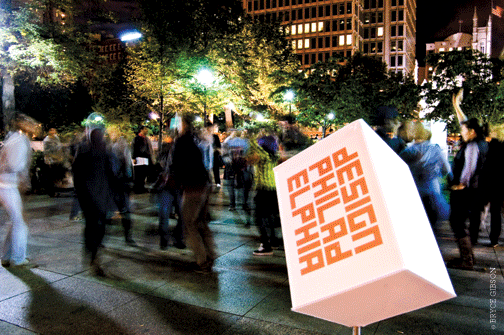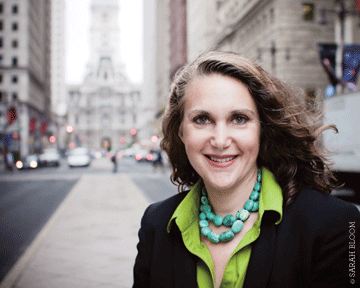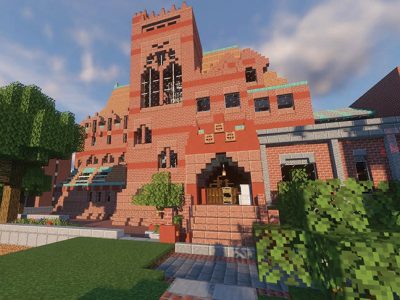
Two years ago, during the annual citywide fest DesignPhiladelphia, parking spots on a busy block in Center City were temporarily inhabited by “interventions.” They included a corrugated cardboard seating area for seven, an acid-green and blue napping module, and a waist-high wooden platform affixed with tens of tiny cars on springs that bobbed to and fro with the whoosh of each passing SEPTA bus. The installations were entries for “Spot,” a competition that challenged designers to reclaim the parking spot and to generate thought about public space. People sat in the cardboard lounge and reclined in the nap pod. Passersby peered at the little bobbing cars. A meter maid got frustrated when she couldn’t figure out how to ticket the installations.

Hilary Jay C’83, founder and director of DesignPhiladelphia, loves to hear about these interactions because they so clearly illustrate her mission.
“Not everyone is willing or feels comfortable going to a gallery or to a design center,” she says. “I want to take design outside and make it experiential, to make it easy for different people to interact with it and be provoked.”
Since its inaugural year in 2005, DesignPhiladelphia has grown to offer more than 100 opportunities (lectures, exhibitions, installations, pop-up shops, events) for provocation, making it the largest festival of its kind in the US.
“It’s an extraordinary asset,” says Gary Steuer, chief cultural officer for the city of Philadelphia. “Philadelphia has a broad array of design excellence, from Web design to product design to landscape architecture. DesignPhiladelphia is a fantastic way to connect the dots and to showcase these strengths to the public.”
Other cities are beginning to take note. While Jay was organizing DesignPhiladelphia 2010, which was held from October 7 to the 17th, she fielded calls from design advocates in Seattle and Boston interested in replicating the event. Jay Corless, a creative social entrepreneur who traveled coast to coast looking at design culture in 30 cities for an upcoming documentary called Cities x Design, ranked Philadelphia in the top 10 cities that recognize design as a cultural, economic, and social asset.
“It was one of the only cities that had a celebration of design,” he says of DesignPhiladelphia, “and that was huge for us.”
While DesignPhiladelphia has its champions, it has also felt the repercussions of a worsened economy. When the festival lost longtime anchor sponsor Philadelphia University in 2009, Jay had to scramble for its survival until she found a new sponsor in the University of the Arts.
But Jay is nothing if not resilient. Since graduating from Penn with a bachelor’s degree in sociology, she’s built a number of businesses from scratch, reinventing herself a few times along the way.
“I’ve never had a job I was actually trained for,” she claims.
Though there has never been a clear blueprint for her own path, the constant throughout has been design. Raised in Baltimore by a graphic-designer father and an interior-designer mother, Jay always faced the expectation that she would do something artistic. Growing up, she collected art awards.
“But I didn’t feel like I was ever going to be good enough to pursue that,” she says. “I’m better at working with someone else, at championing someone else’s ideas.”
In 1985 she backed into launching a jewelry business, Maximal Art, with a friend whose designs hit it big after the Thompson Twins requisitioned a large order for their world tour. By 1990, Jay and her partner were designing five collections of 80 pieces each per year. They had 26 employees, sold wholesale to 2,000 stores worldwide, and their work was featured in books and the permanent collections of the Victoria & Albert Museum and the Musée des Arts Décoratifs in Paris.
After five years, Jay realized she wanted to do more than simply making and selling things.
“I needed to do something to spread the gospel,” she says, “of what designers are doing and why it’s important.”
In 1990 Jay launched a marketing and public-relations company that specialized in design clients, then segued into freelance journalism. She was writing on home and design for Metropolitan Home, ID, and Art & Antiques when The Philadelphia Inquirer hired her to write a weekly design column for the now-defunct Inquirer Magazine. But while writing about everyday things like Band-Aids, cereal boxes, and voting ballots was one way to raise people’s design awareness, it wasn’t enough.
Around this time, she and some friends—an art director at a magazine, a branding expert, and an industrial designer—formed an informal think tank dubbed the Paris Project to brainstorm how Philadelphia could evolve into a center for design. One idea was to found an organization with an exhibition space to shine a spotlight on the city’s heritage as the Workshop of the World. From the late 1800s to early 1900s, Philadelphia was filled with workshops and factories churning out everything from lace to steam engines. Today’s breadth of design firms represents a direct parallel to that turn-of-the-century Philadelphia, but few people realized it.
Serendipitously, Philadelphia University was playing with the idea of repositioning its Paley Design Center, which at the time mostly functioned as a home for the institution’s extensive textile archives. Jay became director in 2000, redubbed the place the Design Center, and proceeded to co-curate exhibitions that drew international press and reviews.
In 2001, she invited fashion designer Todd Oldham to examine the more than 200,000 artifacts in the archives for “Todd Oldham Curates: Oddities from the Paley Textile Collection.” In 2009, “Lace in Translation” brought such internationally renowned designers as Dutch phenom Tord Boontje to Philadelphia to riff on the collection of Quaker Lace.
DesignPhiladelphia grew out of discussions with professors at the university about how to create a symposium to engage with the city’s six other design schools. The idea quickly evolved into a full-fledged design week, fashioned after London’s.
The Design Center at Philadelphia University closed in summer 2010, and today Jay is focused on spreading the gospel solely through DesignPhiladelphia and her work with the city. (She serves on Mayor Michael Nutter W’79’s Cultural Advisory Board as well as on the boards of several arts organizations.) And her faith in design has only grown stronger, she says. “It’s a means to a conversation about the potential that creative force has to alter the way Philadelphia—and any urban center for that matter—operates, thinks about itself, and is seen by others.”
—Caroline Tiger C’96




